Check out my youtube channel for a demonstration.
I also put together a webpage describing how an Apple II controls the switches.

Check out my youtube channel for a demonstration.
I also put together a webpage describing how an Apple II controls the switches.
I have just put up a new essay titled Building a Railroad onto my Stories Page. The download is free.
This is an extensively illustrated essay that contains part of a diary kept by John Morgan, assistant engineer for the U.S. Military Railroad at City point during the siege of Petersburg. The period covered is February 5th to March 6th, 1865, when the City Point and Army Line Railroad was expanded to support the new positions of the Army of the Potomac after the Battles of Hatcher’s Run. I have added much commentary about the U.S. Military Railroad and the events that occurred at this time.
One of the things that I looked at when I visited the National Archives a few years ago, was a journal that had daily entries. These entries loosely described what the engineering and construction corps of the USMRR was up to on each day of the Petersburg champaign. I’m not exactly sure who was responsible for making the entries, but there is handwriting from several different people in the journal. Typical entries reported on the weather, what the various construction gangs were up to, significant military and political events and so on. Like most diaries, the content isn’t that exciting, but there are a few gems in there. Here is one of more interesting entries that I encountered.
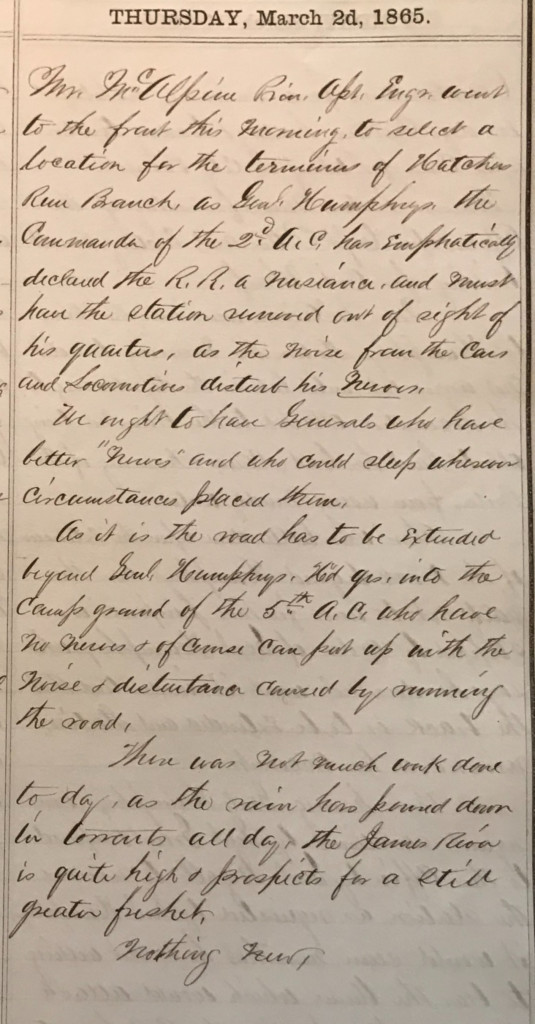
Here is it transcribed.
Thursday March 2d, 1865
Mr McAlpine, Prin. Asst. Engr went to the front this morning to select a location for the terminus of the Hatcher Run Branch as Genl Humphreys, the Commander of the 2nd A.C. has emphatically declared the R.R. a nuisance and must have the station removed out of sight of his quarters, as the noise from the cars and locomotives disturb his nerves.
We ought to have Generals who have better “nerves” and who could sleep wherever circumstances placed them.
As it is the road has to be extended beyond Genl. Humphreys Headquarters into the Campground of the 5th A. C. who have no nerve & of course can put up with the noise & disturbance caused by running the road.
There was not much work done today, as the rain has poured down in torrents all day. The James River is quite high & prospects for a still greater freshet.
Nothing New
There are several remarkable things about this entry.
First of all is the comment about the need for “Generals who have better nerves.” I worked for almost 40 years in various tech jobs for companies big and small. Though it is pretty routine for an individual to complain about a managers decisions, it is extremely rare for anyone to put it down in writing. Usually, that becomes what is known in industry as a career limiting move or a “CLM.” I can only guess that the entry was written either by a civilian employee or someone else that didn’t intend on making the army a career.
The second thing that struck me is how a general might demand that the railroad move it’s terminus so all the activity didn’t disturb his nerves. This caused me to spend some time investigating general A.A. Humphreys to see just what kind of person he was.
What I found was a most interesting man. A graduate of the West Point class of 1831, A.A. Humphreys became a highly respected civil engineer. Before the Civil War, he led the survey that was to plot the route for the first transcontinental railroad. He also started work on a detailed analysis of the Mississippi River that was intended to help the engineers improve navigation. That analysis was published shortly after the war.
Though highly respected, he was apparently very set in his ways and it appears he had few close friends. That he navigated the changes in command of the Army of Potomac with little controversy, is probably a reflection of his independent nature. It appears he had a reasonably good relationship with General Meade, who asked him to be chief of staff of the Army of Potomac after Meade took command. At first Humphreys refused the offer, preferring to remain a division commander. Later on, he was asked again to take the position and accepted. Also, General Abbot, who commanded the siege Artillery at Petersburg worked with Humphreys on the Mississippi River project before and after the war. I wonder if it was Humphreys who recommended that Abbot be put in charge of the siege artillery in front of Petersburg. It is somewhat interesting that with all his knowledge of the Mississippi River, that Humphreys was never sent to assist in the fight on that front.
That an engineer of his esteem would make the USMRR move it’s station because of how it disturbed his nerves is very surprising to me and I believe very reflective of his difficult nature. However, there is the possibility that the engineer Humphreys just didn’t like the location chosen for the station for other reasons than “nerves” and had the USMRR move it to what he considered a better spot.
The American Philosophical Society, which was and is one of America’s leading intellectual societies had a lecture by Hampton L. Carson about Humphreys shortly after his death. This paper described Humphreys as follows.
The life of Andrew Atkinson Humphreys was one of reflection and action, of incident and character. A man of science, a brilliant soldier, an accomplished scholar, a polished gentleman, the lineal descendant of distinguished men, and the inheritor of their talents and virtues, he displayed in every walk of life the highest qualities, and combined the most opposite characteristics. Born to command, he easily attained the front rank in every species of labor which he undertook, yet his modesty was as great, as it was rare. His intercourse with men was graced by a charm of manner, a simplicity of diction, purity of sentiment, a gentle resistlessness of will that armed him with a power which few could oppose with success ; or if, misled by these, they had dared to stir the half-hidden fire of his nature, they would have found him as terrible as Saul. … …he was in public and in private, a man to be feared, to be trusted, to be admired, to be loved ; a man with whom no one could trifle, and whom no one would care to offend.
This picture of him, seems to portray a pretty intense person.
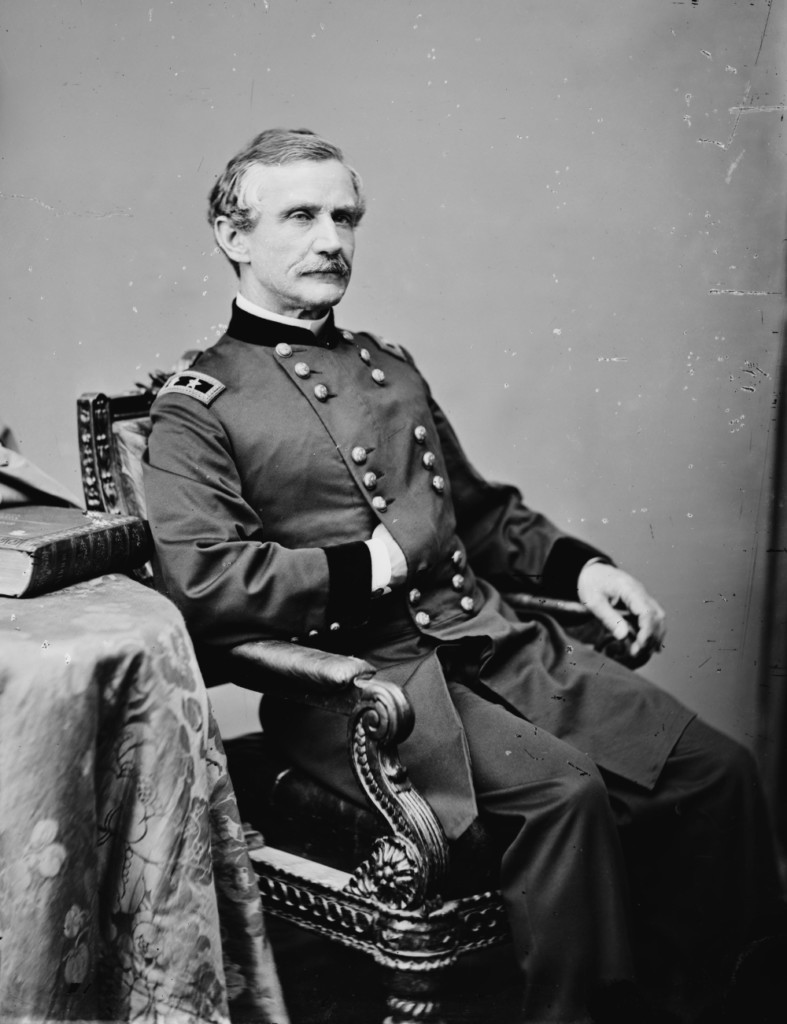
I think this difficult nature also explains how long it took him to attain corps command in the Civil War. However difficult he was, he seemed to know how to defer to superiors, as it seems he was never fired from a job. What do you think about A.A. Humphreys?
I’ve been putting more video’s up on my youtube channel. The latest is a demo of my Macintosh 128K. If you are interested in the history of Macintosh computers, take a look.
I also added a web page with a pretty detailed description of the hardware that I have used to provide automatic locomotive operations.
When I constructed some prototype winter huts for my City Point Model Railroad, I made the assumption that the soldiers used their shelter halves for sides and roofs of the shelters. I cut some paper to the scale size for a shelter half. Like the soldiers would have done, I used these for the roofs and ends of my models. One thing I found is that the shelter halves couldn’t completely cover the ends, so my huts ended up looking like this.
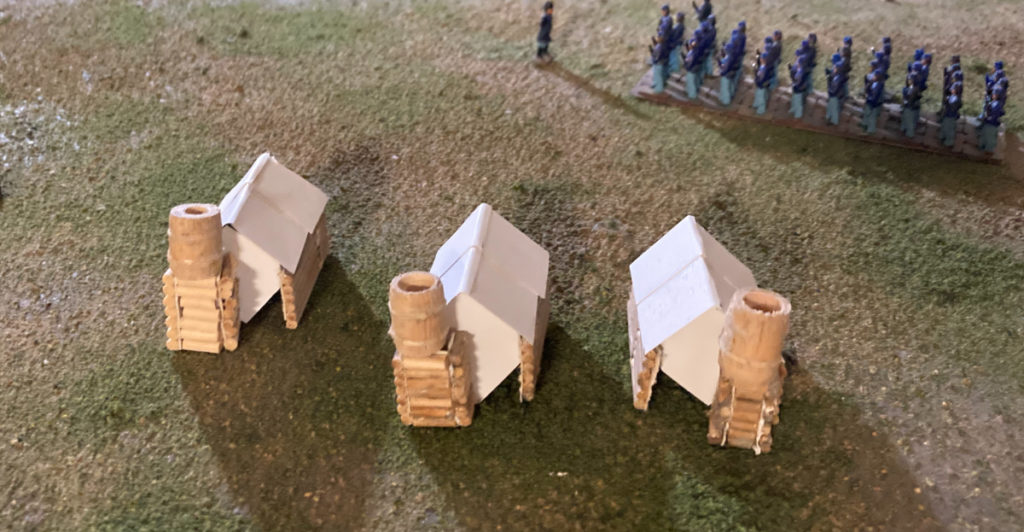
I was looking though some original Civil War images for my City Point Model Railroad and noticed that at least one original hut had the same problem.
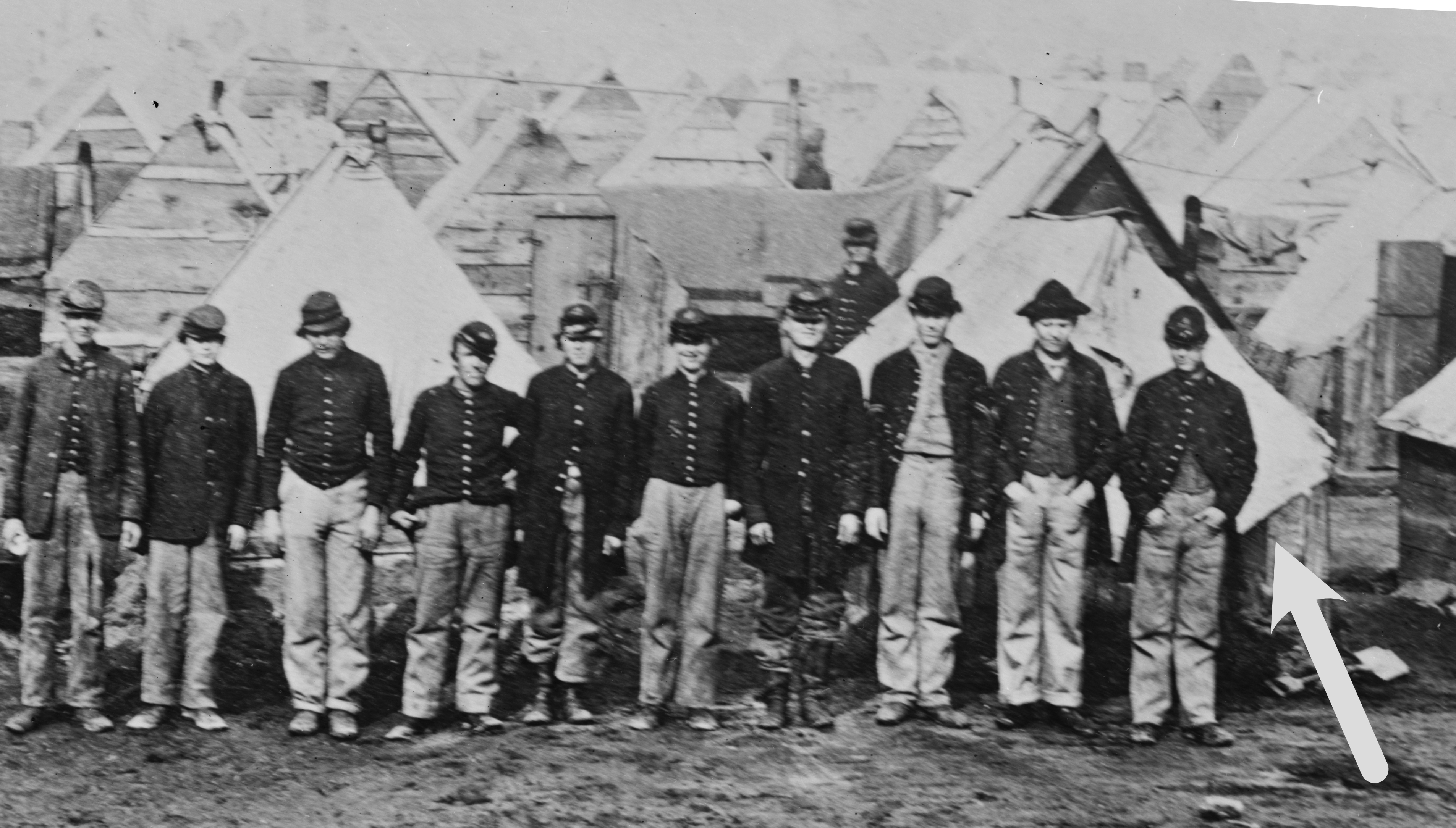
Note how the hut on the right has a shelter half that doesn’t completely cover the end, just like on my model. Looking at this image more closely, it does appear that many of the more enterprising soldiers found enough construction materials to solve this issue. I need many more huts for my layout and will have to build a number of the improved versions.
I had established in a previous post that the dictator was first moved to position in front of Petersburg on July 8th, 1864, and was used against the Chesterfield battery. On August 25th, 1864, the construction corps was tasked with building a platform for it. So what happened between July 8th and August 25th.
On July 12th, the platform car that the Dictator was mounted on broke after only 5 shots. Note that a time bomb blew up an ammunition barge at City Point on the 9th which caused a tremendous amount of damage. The lack of ammo or transportation may account for some of the delay between moving the Dictator up to the front on the 8th and only five shots having been fired by July 12th.
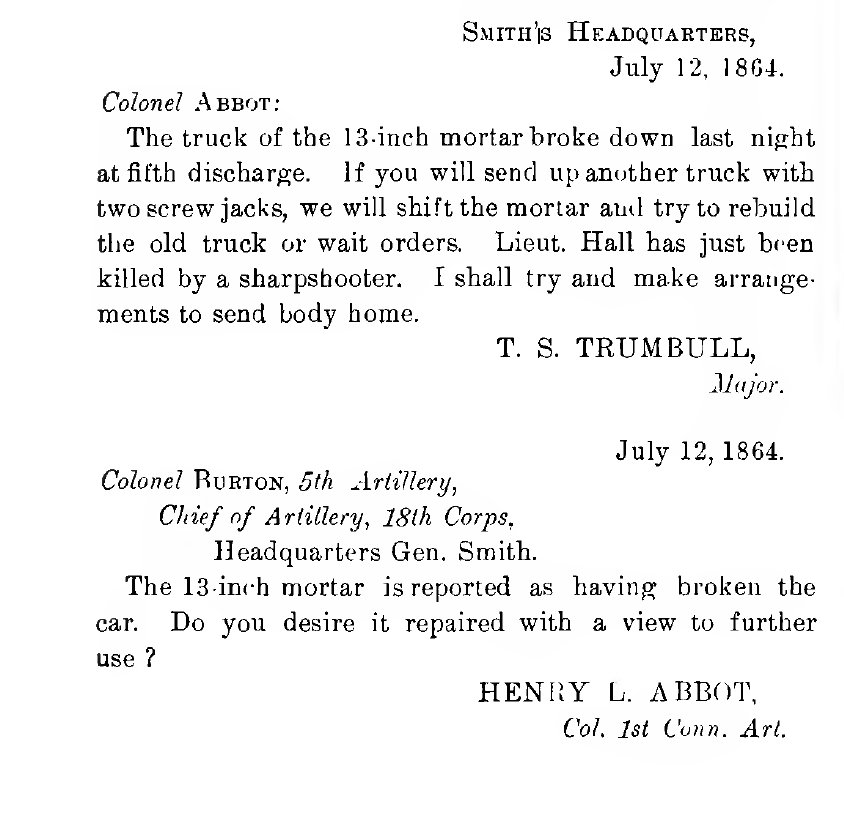
The report of the fate of Lieut. Hall shows just how hazardous duty at the front was. I’m thinking that is an image of the Dictator on that flat car.
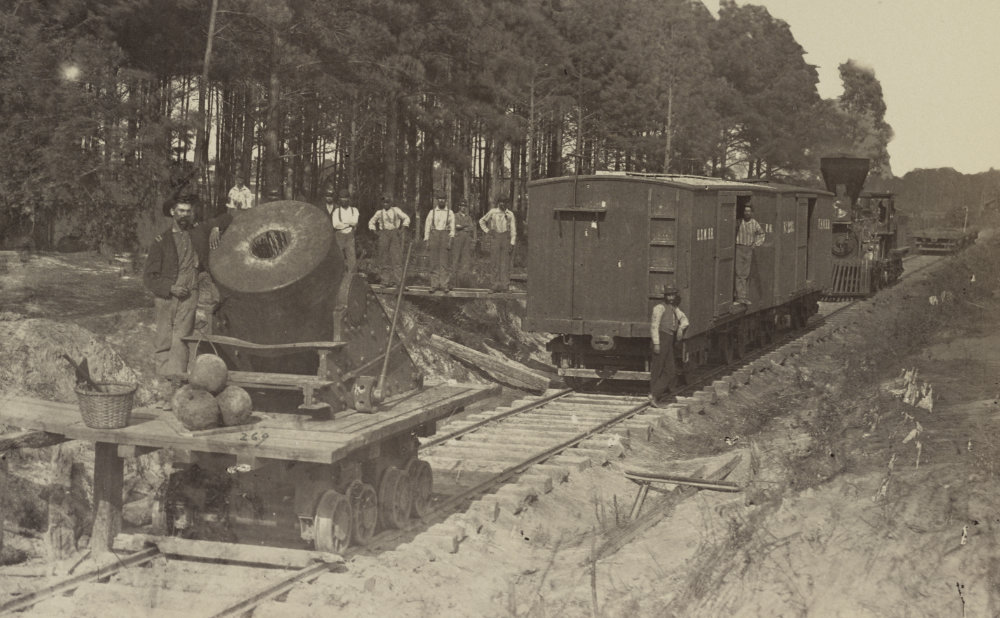
The platform car must have been repaired as the Battle of the Crater was fought on July 30th, 1864 and the Dictator was used to attempt to suppress the Chesterfield battery during that battle. This is part of the report of that battle by Col. Abbot of the 1st Connecticut Artillery.

I wonder how accurate that report from the deserter was. On July 31st, the day after the Battle of the Crater, the 13″ mortar was ordered back to City Point. Why it was ordered back is not known.
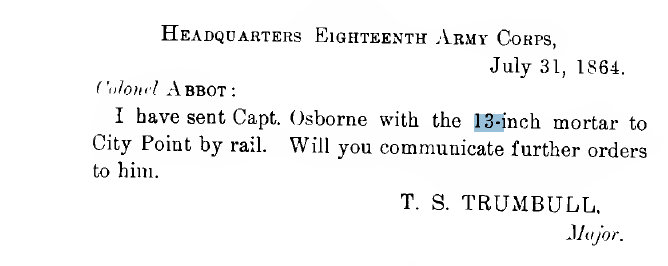
Finally, as was shown in the previous blog post, a dedicated platform was ordered to be built on August 25th. This must be an image of the Dictator relocated to the new platform.
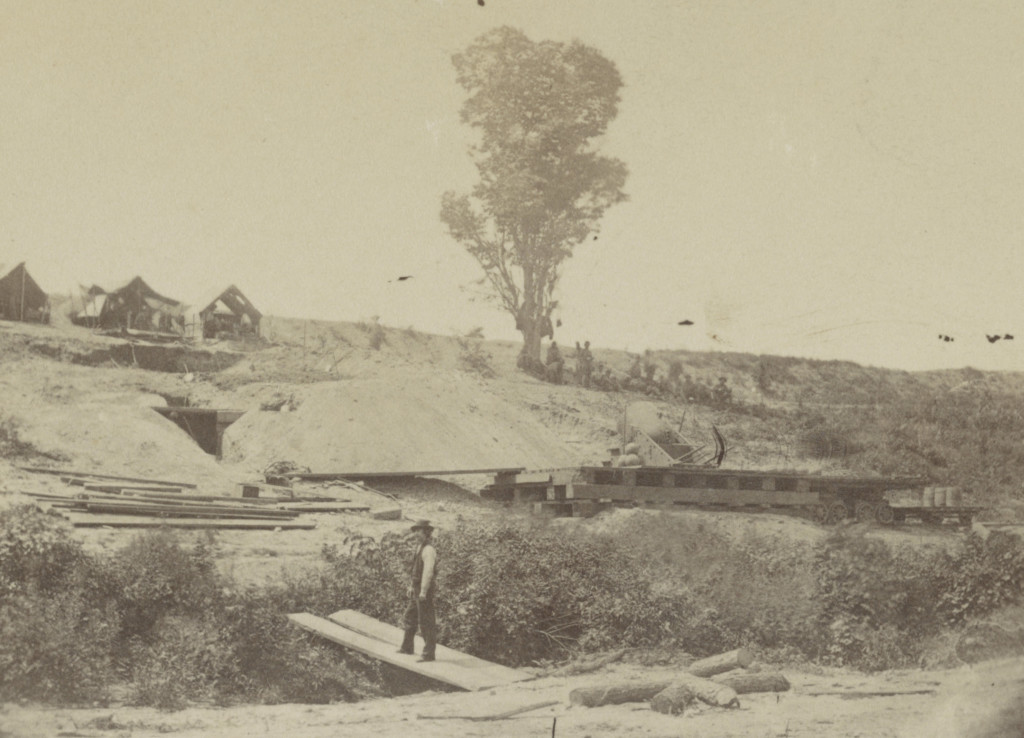
Here is another view of the Dictator on the platform, along with some officers.
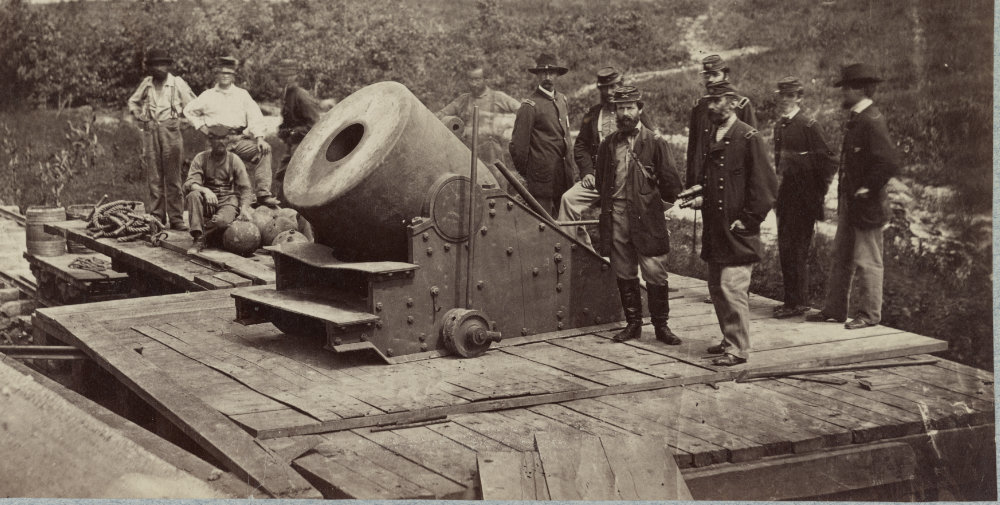
Most of the officers on the platform are identified in the caption of the same image that is included in the book, “The photographic History of the Civil War.”
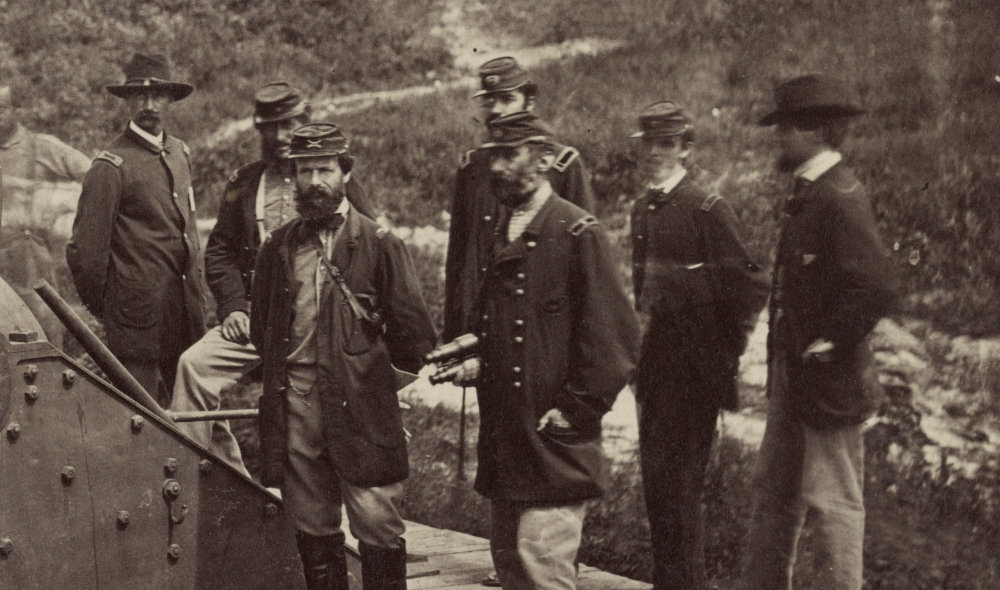
With the binoculars, is Brigader General H.L. Hunt, chief of artillery for the Army of Potomac. To his right is Colonel H.L. Abbott, commander of the 1st Connecticut, which operated all the Union siege artillery during the siege of Petersburg, including the Dictator.
In the rear row, from left to right is, Captain F.A. Pratt, Captain E.C. Dow (just behind Colonel Abbott), an unidentified captain, Major T.S. Trumbull (just behind and to General Hunt’s left) and unidentified person who appears to be a civilian.
Major Trumbull commanded all of the siege artillery in front of Petersburg until September 1st, when poor health forced him to relinquish command. Soon after that, he passed away. I think he has a gaunt look about him in this image, so perhaps he was already failing when this image was taken. Captain Pratt commanded company M of the 1st Connecticut and Captain Dow commanded company F. These companies manned several positions along the siege lines at this time.
I am investigating the identity of the unidentified captain, who perhaps could be Captain W.F. Osborne, commander of company G and the Dictator. Captains Dow, Osborne and Pratt were discharged in October or November, 1864, all having served since May, 1861.
Sometime in late summer or early fall, the Dictator was moved back to City Point and I don’t believe that it was used again.
I decided to see what happened if I put up a short youtube video.This one shows how much (or little) is working on my City Point Terminal Model Railroad. I could make more of these videos, who knows.
Last year, during my research in the National Archives, I took many pictures of entries from a journal kept by the US Military Rail Road Construction Corps. One of these entries discusses the construction of a platform for the 13″ mortar. The weapon now known as the “Dictator.”
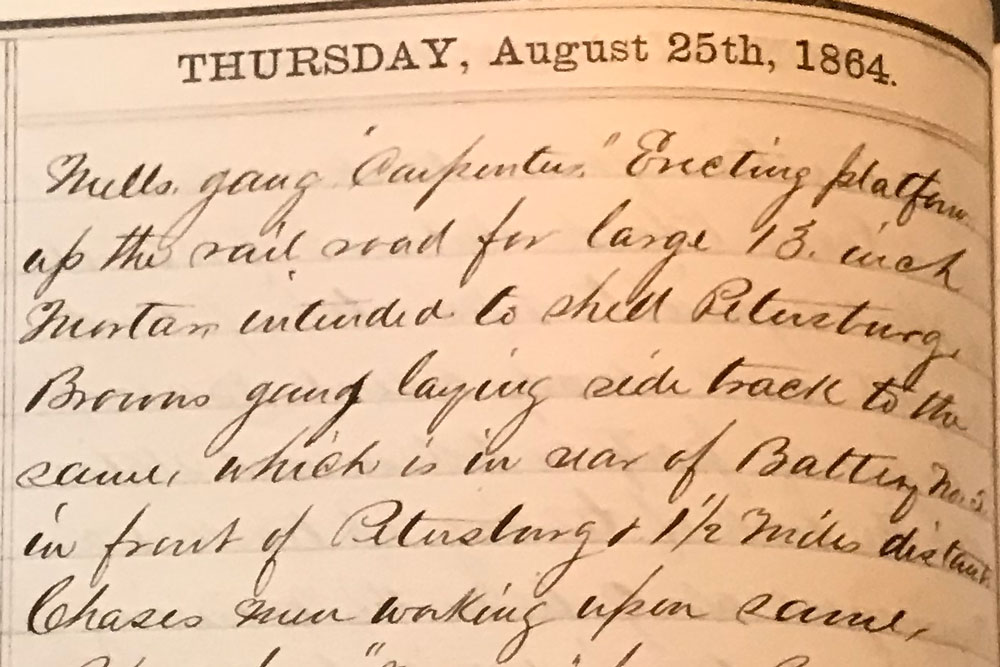
Thursday, August 25th, 1864
Mills gang “Carpenters” Erecting platform up the railroad for large 13 inch Mortar intended to shell Petersburg. Browns gang laying side track to the same, which is in rear of Battery No. 5, in front of Petersburg 1 1/2 miles distance.
Though this entry notes that the intention was to shell Petersburg, the reality was different. The 13″ mortar was positioned with an intention to suppress Confederate artillery that were posted in a rather advantageous position that flanked the right of the Union lines. The artillery in this position troubled the Union troops from the Second Battle of Petersburg through to the end of the siege, as the Union troops never were able to effectively suppress it. The nature of this flanking position can be clearly seen in this map of the positions of the Union 1st Division of the 9th Corps on April 1st, 1865. I added the red arrows showing the field of fire of the flanking Confederate batteries.
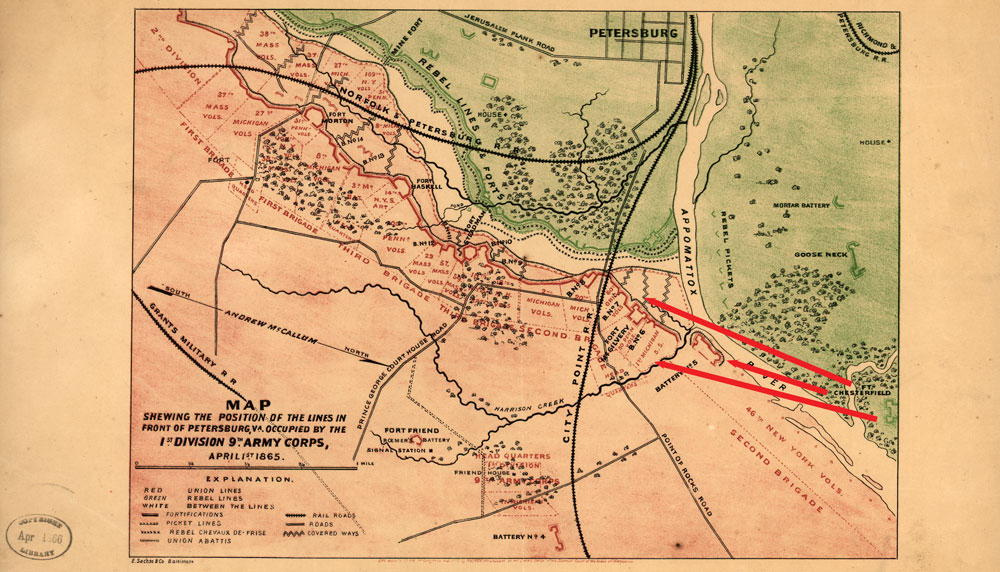
More can be found out about this problem and the 13″ mortar’s role in it, in the book, “History of the First Connecticut Artillery.” This unit operated the Union siege artillery during the siege of Petersburg, including the 13″ mortar. This regimental history is put together much like the Official Records, and is largely a compilation of surviving documents concerning the regiment. There are some additional notes added by the editors. This particular note spans pages 68 and 69 and describes how the 13″ mortar was used.
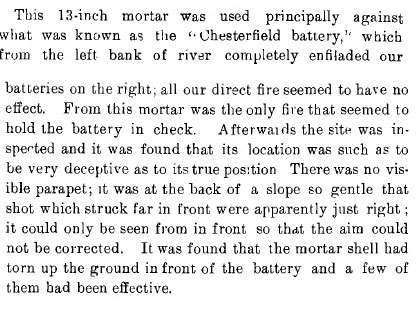
Though I haven’t done an exhaustive search through this book, the earliest reference to the 13″ mortar is on July 8th, 1864. In this memo, it is clear that the 13″ mortar is already in position on a truck carriage.
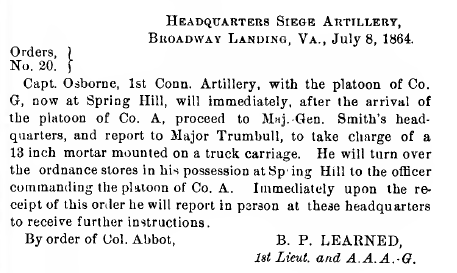
This additional message seems to indicate that the 13 inch mortar is just being brought up into line on the 8th, so Captain Osborne must have been the first commander of this mortar.
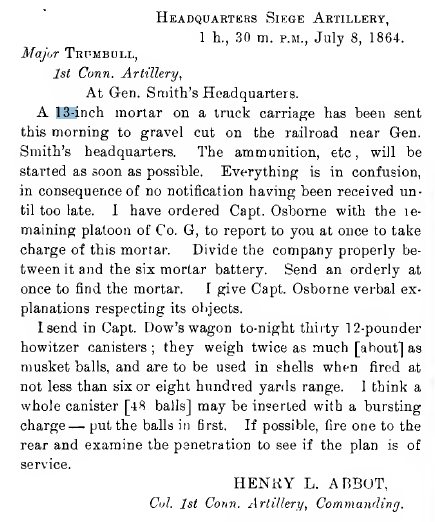
Right now, that’s all I have time for. I’ll elaborate on why there are orders to build a platform for the 13 inch mortar on the 25th of August, more than two weeks after it was first put into service, in a follow up post.
The classic image of the Civil War portrayed by authors like Bruce Catton had men and horses marching on foot for days over dusty or muddy roads. This would be interrupted by an occasional horrible and not quite decisive battle. While this image of war is certainly true, there is another side to what was going on during the Civil War.
Troops were often transferred vast distances by rail or boat. Telegraphs were setup to provide almost instant communication across the same vast distances. Steam powered gunboats patrolled the rivers. Hospitals were supplied with running water. By the end of the war, economic warfare was a key part of the North’s strategy, while the southern forces embraced raiding and guerrilla warfare. Most northern cavalry units were equipped with breechloading rifles, many of them repeaters. Hydrogen balloons were used for observation, though later in the war it was determined that, if given a few days time, building a tall tower could achieve a similar result, with a lot less hassle and risk.
When I stopped at the National Archives late last year, I discovered that the men staffing the US Military Rail Road’s depot in Alexandria Virginia enjoyed some surprising luxuries. I found invoices for gas pipe and gas lanterns. Further research indicates that a gas works was installed in Alexandria in the 1850s. The USMRR railroad must have tapped into it.
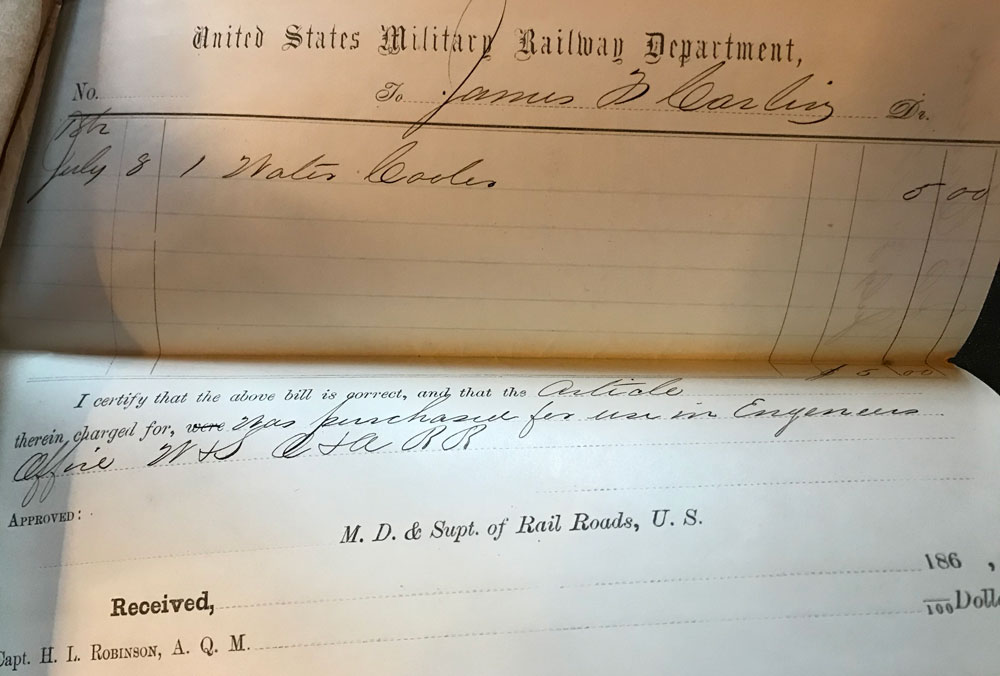
I also found invoices for water pipe, a water cooler and 800 pounds of ice. Finding the invoices for the ice and water cooler was quite a surprise.

Though those times were primitive by today’s standards, it’s clear that when possible, those soldiers would do what they could to make themselves as comfortable as possible.
The enigma of U.S. Grant is an ongoing puzzle to me and many other people. It’s hard to reconcile the failed farmer with the man who became the most successful general of the Civil War and afterward, the president of the United States.
I found this letter in the National Archives concerning a water tank constructed near General Grant’s headquarters at City Point. I think it sheds a little light into how Grant expected his soldiers to perform and perhaps a hint at why he was so successful as a general.
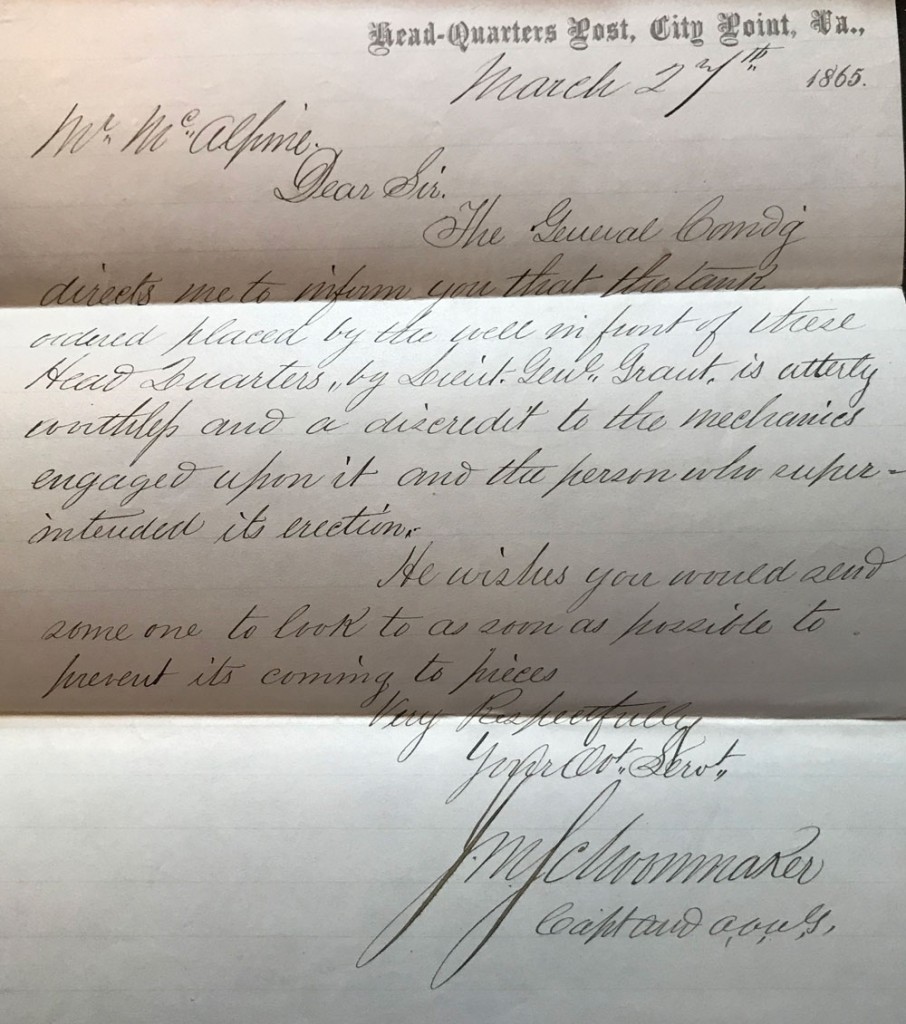
March 24th 1865
Mr McAlpine,
Dear Sir.
The General commanding directs me to inform you that the tank ordered placed by the well in front of these HeadQuarters, by Lieut. Genl. Grant is utterly worthless and a discredit to the mechanics engaged upon it and the person who superintended its erection.
He wishes you would send someone to look to as soon as possible to prevent its coming to pieces
Very Respectfully
Your Obt. Servt.
S M Schummaker
Captain — —-
Note that I’m not sure about the spelling of this captains name or his position at HQ. I also find the letterhead kind of interesting. There were so many different letterheads found in those few archives that I perused that I have contemplated trying to make a list of the varieties.